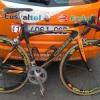Here is a listing of a DOSS formulation with prop glycol from the Mason Chemical Company that claims low toxicity of it.
Macat® DOSS-70PG S/DOSS-75E
Products
Dioctyl Sodium Sulfosuccinate
MACAT DOSS-70PG S is a 70% active di-2-ethylhexyl sodium sulfosuccinate in water and propylene glycol, DOSS-75E is 75% active in water and ethanol. DOSS-70PG S and DOSS-75E have broad FDA Status, and offers compatibility in a wide range of solvent systems for use as a versatile wetting, dispersing, emulsifying and detergent ingredient.
The exceptional quality of MACAT DOSS-70PG S/DOSS-75E allows for use in a wide range of markets and applications. DOSS-70PG S/DOSS-75E delivers rapid reduction in surface tension for improved wetting, adhesion, gloss and color resolution, and flow characteristics in Ink & Overprint Varnish Systems. In Emulsion Polymerization, DOSS-70PG S/DOSS-75E provides efficient particle generation at low concentrations for production of latexes with low particle size and narrow distribution. Use as a wetting and dispersing agent in Textiles and Paper, and penetrating and emulsifying agent in Dry Cleaning Formulations.
MACAT DOSS-70PG S/DOSS-75E is biodegradable (>66% by 28 days in the closed bottle test), exhibits very low toxicity with an Acute oral LD50 (Rats) of >4g/kg and Acute dermal LD50 (Rabbit) of >10g/kg, causes minimal eye irritation, and not considered a primary dermal irritant. INCI Name: Diethylhexyl Sodium Sulfosuccinate, CAS# 577-11-7
INCI Name: Diethylhexyl Sodium Sulfosuccinate
CAS# 577-11-7
Edited by malbecman, 14 February 2008 - 06:20 PM.
















































